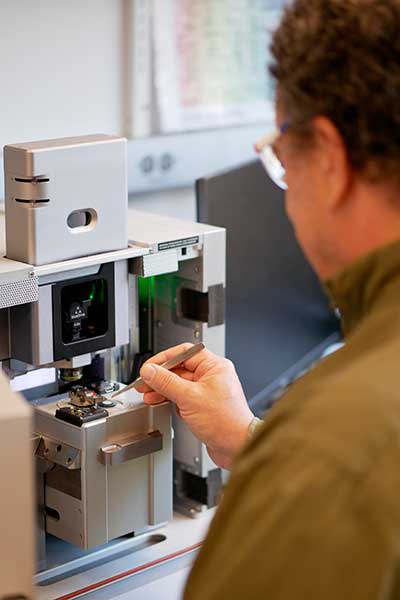Lustig Issued Seven Patents for New Kevlar® EXO™ Product by DuPont

Steve Lustig, associate professor of chemical engineering, was a major contributor to a new product by DuPont called Kevlar® EXO™, a novel, ultra-high-performance copolymer that offers added strength and resilience. Through this collaborative research, Lustig has been issued seven patents for his technology.
Steve Lustig, associate professor of chemical engineering, was a major contributor to a new product by DuPont called Kevlar® EXO™, a novel, ultra-high-performance copolymer. Through this collaborative research, Lustig has been issued seven patents for his technology.
DuPont created the original version of Kevlar®—a strong, heat-resistant, and lightweight synthetic fiber used in everything from bulletproof vests to boat sails—in 1965. With this new iteration, they sought to harness Lustig’s expertise in the design and manipulation of molecular and materials chemistry and structure to create a fiber that was even stronger and lighter and with improved anti-ballistic capabilities.
“Kevlar® is a unique material because it has a very repetitive structure—benzene, amide, benzene, amide—which creates strong hydrogen bonds between neighboring chains in sheets,” says Lustig, who worked at DuPont Central Research & Development for 26 years before joining Northeastern in 2016. “However, after many years of processing this material, they realized they were only getting about 10 percent of the possible strength because it’s challenging to get that many hydrogen bonds aligned; one defect can affect the crystalline structure, and therefore cause weakness.”
Lustig’s goal was to make the structure even more perfect, which he accomplished by finding a monomer with its own ability to hydrogen bond to neighboring chains that he could mix into the composite in just the right size and shape. When heat-treated and cooled, the chains aligned even more perfectly, resulting in a stronger material.

Steve Lustig working in the lab.
“A lot of previous researchers thought if you want a strong fiber, you need high tensile strength—the stronger you make a polymer in tension, that faster the bullet you’d be able to stop,” says Lustig. “It turns out that if you also make the fibers strong in transverse compression—against the direction of the fiber—you improve its ability to be a better armor. Stronger fibers mean you need to use less material, which also makes it lighter.”
DuPont’s primary intended application for Kevlar® EXO™ is in protection for military personnel, police, and first-responders. Looking forward, the material also has plenty of opportunities to improve performance in other industries as well.
“This material has a lot of uses in high-performance applications where you need high strength,” says Lustig. “Using them in tire cords can make vehicles more efficient, resulting in better gas mileage or less electricity used. Fibers are also being used to reinforce epoxy resins in aircraft, which makes them lighter and stronger and burns less jet fuel. A new composition like Kevlar® EXO™ will hopefully help DuPont continue to innovate and thrive.”
Lustig’s lab at Northeastern also engages in similar research for discovering new property, functionality, and technology using quantum chemistry, statistical mechanics, polymer physics, and materials and biomolecular engineering.
“Our latest work is funded by the U.S. Army working on two-dimensional polymers,” says Lustig. “With Kevlar®, the covalent bonds are linear and the hydrogen bonds are in a flat plane, but a 2D structure has covalent bonds in a plane and hydrogen bonds in a perpendicular direction between planes, making for an even stronger material.” Lustig’s research in this area was also published by the American Chemical Society.
Through this research, Lustig’s team became the first to create two-dimensional polymers called graphamid and graphimine, which the Army intends to utilize in protective armor, fire-resistant clothing, high temperature applications, and electronic materials.